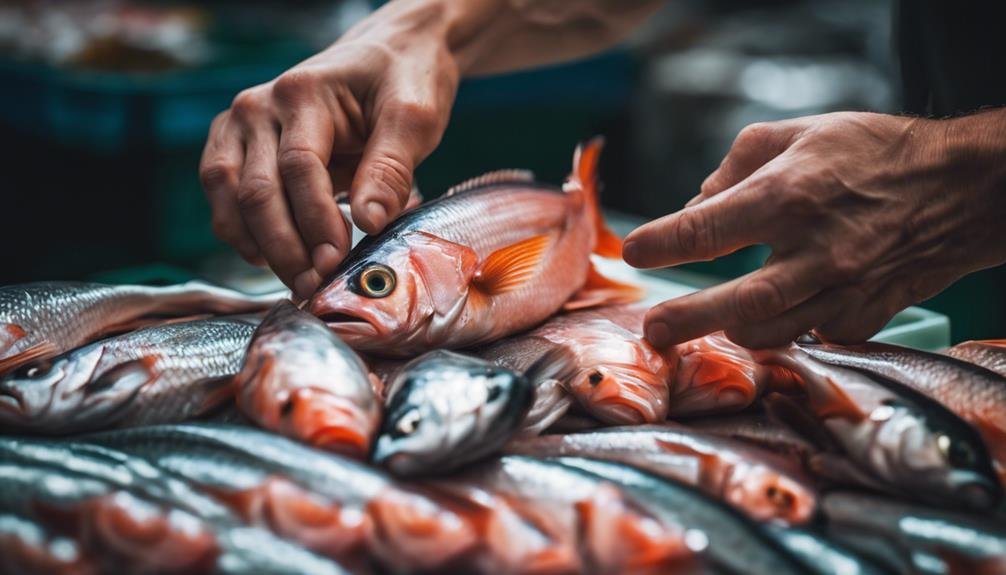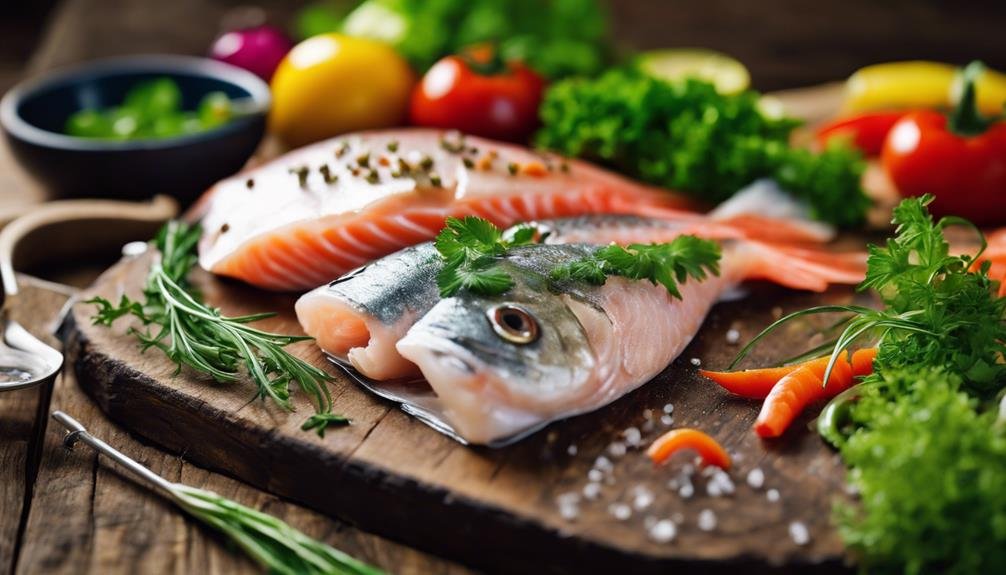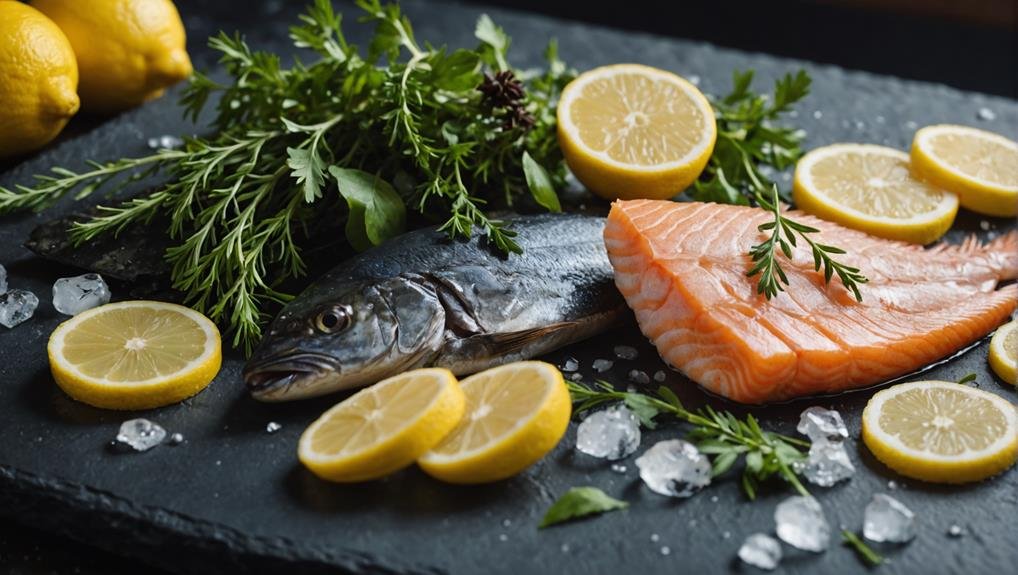You’re about to explore the world of raw Fish, a culinary delight featured in dishes like sashimi, ceviche, and poke. Selecting the freshest Fish is essential—you’ll need to know what to look for, like clear eyes and firm flesh. Knife skills also play a pivotal role in achieving those perfect, thin slices. But there’s more to it than just picking and slicing; you must also consider safety measures to guarantee it’s delicious and safe to eat. Are you curious about how to master these aspects and enjoy raw Fish confidently? Let’s get into the details.
Key Takeaways
- Select Fish with clear eyes and firm, vibrant flesh for freshness.
- Use a sharp, non-serrated knife for clean cuts and uniform slices.
- Store fish below 40°F and freeze at -4°F for seven days to kill parasites.
- Popular raw fish dishes include sashimi, ceviche, poke, crudo, and aguachile.
- Purchase from trusted suppliers and maintain hygiene to minimize health risks.
Selecting High-Quality Fish

When selecting high-quality Fish for raw dishes, look for clear, plump eyes and firm, bouncy flesh as signs of freshness. These indicators are important because the Fish’s quality directly affects your dish’s taste. Safety signifies the Fish is fresh, while cloudy or sunken eyes suggest it’s past its prime.
Another key factor is the texture of the flesh. Press gently on the Fish; if the flesh returns immediately, it’s a good sign of freshness. This bouncy flesh means the Fish is firm and hasn’t started to deteriorate.
Additionally, the color of the Fish, especially for larger types like tuna or salmon, should be bright and vibrant. Dull or discolored Fish is a red flag for lower quality.
To consistently get sushi-grade Fish, establish a relationship with a trusted local fishmonger. They can guide you in selecting the best Fish for raw consumption and often have access to high-quality, sushi-grade options.
Knowing these indicators and having a reliable fishmonger will ensure you always get the freshest Fish for your raw dishes.
Knife Skills for Raw Fish
Selecting high-quality Fish is just the beginning; mastering knife skills guarantees you can prepare raw fish dishes precisely and easily. A sharp knife is vital when slicing raw Fish, as it makes clean, precise cuts.
A non-serrated knife, kept well-maintained and sharpened, ensures you can easily and safely handle various fish types, including mackerel, fluke, salmon, yellowtail, and albacore.
Investing in a high-quality knife is essential. It will help you fillet Fish efficiently, preserving its integrity and texture. When filleting Fish, start by making a clean incision behind the gills, then run your knife along the spine, separating the fillet from the bones.
For slicing raw Fish, use smooth, single strokes to produce uniform pieces that enhance your dish’s presentation and taste.
Knife skills aren’t just about the technique and maintaining the tool. Regular sharpening and proper knife care will make preparing raw Fish enjoyable and efficient.
Master these skills, and you’ll elevate your raw fish dishes to a professional level.
Safety and Storage Tips

To guarantee the safety and quality of your raw Fish, always store it below 40°F to inhibit bacterial growth. Proper storage is vital, especially when preparing raw fish dishes like sushi and sashimi. Using sushi-grade Fish minimizes the risk of parasites and ensures a safer dining experience.
Here are some essential tips to keep your raw Fish fresh and safe:
- Maintain appropriate storage temperature: Keep your Fish refrigerated at or below 40°F.
- Freeze Fish properly: Freezing Fish at -4°F for at least seven days kills most parasites.
- Prioritize sanitation: Always clean your hands, utensils, and surfaces when handling raw Fish.
- Monitor freshness: Check for any off smells or discolorations indicating spoilage.
Bacterial contamination is a significant concern when dealing with raw Fish, so always prioritize cleanliness and proper handling. Ensuring that your storage temperature is consistently low helps maintain the freshness and safety of your Fish. Freezing is another effective method to eliminate parasites and extend shelf life.
Adhering to these guidelines enhances the quality of your raw fish dishes and protects you and your guests from potential health risks. Properly handling and storing sushi-grade Fish are paramount to enjoying safe and delicious raw fish meals.
Popular Raw Fish Dishes
Explore the world of raw fish dishes and uncover the rich culinary traditions that make them so beloved across different cultures. Popular raw fish dishes like ceviche, sashimi, poke, crudo, and aguachile showcase the diverse ways raw seafood can be enjoyed.
Ceviche is a staple in Latin American cuisine. It involves marinating raw Fish in lime juice, combined with fresh herbs and chili peppers. This vibrant dish brings the flavors of the sea to your plate.
In Japan, sashimi offers a pure experience of raw tuna and other Fish, served without sushi rice, emphasizing the Fish’s freshness and texture.
Hawaiian poke features cubed raw tuna marinated in soy sauce and sesame oil, often paired with seaweed and avocado, creating a beautiful blend of flavors.
Crudo, found in Italian and Spanish cuisines, consists of thinly sliced raw Fish drizzled with olive oil and lemon, bringing a Mediterranean twist to raw seafood.
Aguachile, a Mexican delicacy similar to ceviche, marinates raw Fish in a spicy green chili sauce, adding a fiery kick. Each dish highlights popular raw fish dishes’ versatility and cultural significance, offering a delicious journey through global flavors.
Health Benefits and Concerns

While savoring the rich flavors of raw fish dishes, it’s important to consider their health benefits and potential concerns. Eating raw Fish can be nutritious, packed with omega-3 fatty acids, protein, and essential nutrients that promote heart health and overall well-being.
However, consuming raw Fish also comes with health risks, particularly related to parasites and bacterial contamination.
Following proper handling and sourcing guidelines is vital to guarantee safe consumption, whether dining out in New York City or preparing raw Fish at home. Here are some key points to keep in mind:
- Parasites: Freezing raw Fish at -4°F (-20°C) for at least seven days can kill parasites like Anisakis and Diphyllobothrium, reducing infection risks.
- Bacterial contamination: Raw Fish must be stored below 40°F (4°C) to prevent the growth of histamine-producing bacteria that can cause food poisoning.
- Proper handling: Always use clean utensils and surfaces when preparing raw Fish to avoid cross-contamination.
- Sourcing: Purchase raw fish from reputable suppliers who follow strict safety protocols to minimize health risks.
Conclusion
By immersing yourself in the guidelines for selecting high-quality Fish, honing your knife skills, and adhering to safety and storage tips, you’ll confidently prepare delicious raw fish dishes.
Enjoy favorites like sashimi, ceviche, and poke while reaping the health benefits they offer. Remember, freshness and proper handling are key.
Explore the world of raw Fish and elevate your culinary adventures with its unique flavors and textures. You’ll find it both nutritious and incredibly satisfying.
FAQs
Is it safe to eat raw Fish?
Yes, eating raw Fish can be safe if it’s handled and prepared correctly. However, there are risks associated with consuming raw Fish, such as exposure to bacteria, parasites, and toxins. To minimize these risks:
- Source Wisely: Purchase raw Fish from reputable suppliers who follow strict safety guidelines.
- Proper Freezing: Freezing Fish at -4°F (-20°C) for at least seven days can kill most parasites.
- Freshness: Ensure the Fish is fresh and stored at the correct temperature to reduce bacterial risks.
- Health Considerations: Due to the higher risk, certain groups, such as pregnant women, young children, and those with weakened immune systems, should avoid raw Fish.
What are the health benefits of eating raw Fish?
Eating raw Fish offers several health benefits:
- High in Omega-3 Fatty Acids: Raw Fish, especially fatty types like salmon and tuna, are rich in omega-3 fatty acids, which are beneficial for heart health, reducing inflammation, and supporting brain function.
- Rich in Protein: Raw Fish provides high-quality protein essential for muscle repair, growth, and overall health.
- Low in Calories: Raw Fish is generally lower in calories than cooked Fish, making it a good option for those managing their weight.
- Nutrient Retention: Eating Fish raw helps retain more vitamins, such as vitamin D, and minerals like selenium, which might degrade during cooking.
What types of fish are safe to eat raw?
Several types of fish are commonly eaten raw in dishes like sushi, sashimi, and ceviche, including:
- Salmon: Known for its rich flavor and buttery texture, salmon is a favorite for sushi and sashimi.
- Tuna: With its meaty texture and mild taste, tuna is one of the most popular raw fish choices.
- Yellowtail (Hamachi): A firm, slightly sweet Fish often enjoyed in sushi and sashimi.
- Mackerel (Saba): A rich, flavorful fish often marinated before serving raw.
- Snapper: Commonly used in ceviche, snapper has a delicate flavor and firm texture.
How should I prepare raw Fish at home?
To safely prepare raw Fish at home:
- Choose Sushi-Grade Fish: Buy Fish labeled as “sushi-grade” or “sashimi-grade” from a reputable supplier. This indicates that it has been handled and frozen to minimize parasite risk.
- Keep It Cold: Store the Fish in the refrigerator until ready to use and prepare it on a clean, cold surface.
- Cleanliness: Wash your hands, utensils, and cutting boards thoroughly before and after handling raw Fish to prevent cross-contamination.
- Slice Properly: Use a sharp knife to make precise cuts, slicing against the grain to ensure tenderness.
- Serve Immediately: Raw Fish should be served immediately after preparation to ensure freshness and reduce the risk of bacterial growth.
What are the risks of eating raw Fish?
Eating raw Fish carries certain risks, including:
- Parasites: Raw Fish may contain parasites like Anisakis, which can cause gastrointestinal distress if ingested.
- Bacteria: Harmful bacteria like Salmonella and Vibrio can be present in raw Fish, leading to foodborne illness.
- Toxins: Certain fish species may accumulate toxins, such as mercury or ciguatera, which can be harmful if consumed in large amounts.
- Allergic Reactions: Individuals with fish allergies can experience severe reactions, even from small amounts of raw Fish.
How can I reduce the risks when eating raw Fish?
To reduce risks when consuming raw Fish:
- Freeze Fish Properly: Freezing Fish at the recommended temperatures can kill most parasites.
- Choose Fresh Fish: Ensure the Fish is fresh, with clear eyes, shiny skin, and a mild, ocean-like smell.
- Use Clean Tools: Always use sanitized knives, cutting boards, and utensils when preparing raw Fish.
- Eat in Moderation: To avoid potential toxicity, limit your consumption of raw Fish, especially high-mercury species like tuna.
- Consult a Doctor: If you have a compromised immune system, are pregnant, or have health concerns, consult a healthcare professional before consuming raw Fish.
Following these guidelines, you can safely enjoy raw Fish while reaping its health benefits and savoring its unique flavors.

